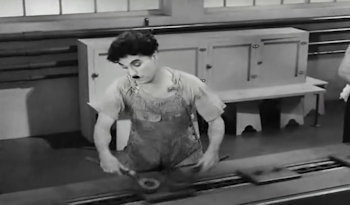The operators may move fast on the production line, make straightforward repetitive tasks and put their best effort into it … this is by far not the fastest production technics. And a camera or a supervisor shouting on his shoulder will not help further
Please add/comment on the right
The Touch-Move Rule
In production also, both for manual and automated assembly, apply the chess game principle:
Once a piece has been touched, it must be played!

Same in production, simple, repetitive steps are not the fastest.
Do not release a component until it has been fully mounted; do not release to temporary stock or workplace a finished subassembly, but mount it directly to its main assembly.
This is the main gain in the envelope game above: taking, then releasing, then taking again (…) the envelopes are clearly the waste -the Muda-.
The gain that ones would think about making the task much simpler & repetitive is simply not there compared to the additional operation.
One-piece flow versus mass production is best demonstrated by:

Production Flexibility Technics
Henry Ford in the 1900s:
“Any customer can have a car painted any color that he wants so long as it is black”
in My Life and Work (1922)
While being part of a logical production evolution, that logic is not the most adapted anymore to most modern market segments. Competitor, time to market, customer demand, and low inventory (…) make flexibility one of the main criteria in today’s production:
- Flexibility on the volume of production
- flexibility on the products themselves: variants, customizations
Here is a review of different technics, from simple to complex to meet flexibility on the product and the production volume. But keep in mind that the two likely have to be combined
Flexibility in the Production capacity
| Method | picture or example | + | – |
|
operating on several shifts 1 to 3 shifts + week-ends eventually = human increase |
one of the oldest methods, relatively easy to implement can be extended to weekends no need for more investments |
as long as you have qualified resources available; usually best operators are spread between the shifts in between less or no-experienced operators sometimes a supervision problem (night shifts) and/or quality variations. flexible only to a certain extent: for very big factories in western countries, not too much a flexible mean (big amount of workers suddenly with no work) |
|
|
doubling or more) the production line = equipment increase |
should be done only when the initial investment possibility is just on the limit (typical: start-ups); and even in such case, there is likely another solution below that could be adapted or visibility of future production is very low backup if (and even, in this case, predictive maintenance should be preferred) |
doubling investments, settings, controls possible product variation |
|
Flexibility on the products themselves -variants- within the same line
How useful was this post?
Click on a star to rate it!
Average rating 4 / 5. Vote count: 1
No votes so far! Be the first to rate this post.
We are sorry that this post was not useful for you!
Let us improve this post!
Tell us how we can improve this post?

It’s fascinating to see how principles from chess and even historical references like Henry Ford’s assembly line still influence production strategies today, yet need adaptation.
It provides insightful comparisons between traditional mass production and modern flexible production techniques, emphasizing the importance of adaptability in today’s market. The touch-move rule analogy is particularly thought-provoking, as it highlights the inefficiencies in handling components multiple times, suggesting that streamlined processes can significantly reduce waste and improve productivity.